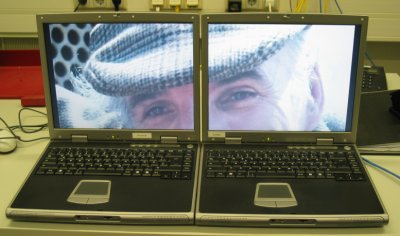Multimedia barriers drop at CeBIT in March
Feb 17, 2005 — by LinuxDevices Staff — from the LinuxDevices Archive — views The Network-Integrated Multimedia Middleware developed at Saarland University in Saarbrucken, Germany, is platform- and network-agnostic, enabling it to crash through previous barriers to distributed multimedia. At CeBIT next month, NMM will strut its stuff as representatives of the university's Computer Graphics Lab demonstrate the extraordinary flexibility of their wares.
The Network-Integrated Multimedia Middleware developed at Saarland University in Saarbrucken, Germany, is platform- and network-agnostic, enabling it to crash through previous barriers to distributed multimedia. At CeBIT next month, NMM will strut its stuff as representatives of the university's Computer Graphics Lab demonstrate the extraordinary flexibility of their wares.
NMM can run on a Windows, Unix, or Linux operating system, but most of the concepts to be demonstrated at CeBIT will be running on Linux machines, according to the lab's Marco Lohse. As far as NMM is concerned, the devices on a network are all virtual devices, such that “a commodity mobile phone can become a radio receiver or the same video recording can be displayed on three TV sets simultaneously,” he explained.

NMM, shown distributing an image across two laptops — one running Linux, and the other running Windows
With NMM, multimedia content is readily shared among networked devices and even “handed over” from one to another. One example is media playback, a task which can be handed over from a mobile MP3 player to a hi-fi system in a living room, for example, as a person approaches and then enters his house. The demonstrations at CeBIT will be hosted by a multimedia PC, a laptop, and three PDAs, all running Linux. The PC, a “barebones” system from MSI, hosts a “Multimedia Box” that the lab says provides “an integrated and extensible software solution” for a networked home entertainment center.
In addition to live demonstrations, representatives of Saarland's graphics lab will report on a number of previous demonstrations of NMM's capabilities. In one, audio is handed over from a Linux PDA to a conceptual car infotainment system. In another, MP3 audio is moved back and forth between the PDA and a Multimedia Box.
The latter, Lohse explained, demonstrates “a synchronized continuous session handover: active parts of a flow graph for decoding and playback of audio data are moved to a different host during runtime, while keeping the playback continous and synchronized.” In this application, playback was then conducted on both the PDA and Multimedia Box simultaneously “for demonstration purposes.” Lab staff measured the offset of the two audio streams during handover. The typical result was a mere 1 to 2 milliseconds.
The Computer Graphics Lab at Saarland is continuing to build an NMM infrastructure for Linux and other operating systems. Its software, in the meantime, is available in LGPL and GPL for licensing “within Open Source and research projects,” as well as in commercial products. A spin-off commercial entity is in the works for proving professional support for NMM.
See them at CeBIT 2005, March 10-16, in Hall 9, Booth D09.
This article was originally published on LinuxDevices.com and has been donated to the open source community by QuinStreet Inc. Please visit LinuxToday.com for up-to-date news and articles about Linux and open source.